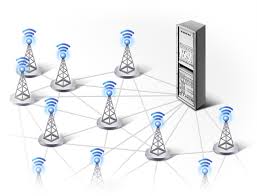
© copyright telecomdocs.com

© copyright iotone.com
The Base Station Subsystem (BSS) (part of the 2G network) consists of 2 components; the Base Transceiver System (BTS) and the Base Station Controller (BSC). The role of the BSS is to take the wireless communications from the mobile station and convert it into a suitable state to be move on through the fixed line network; and the reverse
The BTS is the mast, which receives the data wirelessly from the mobile station and passes this, onto the the BSC. This is actually the only part of the mobile phone system that deals with the wireless communications.The wireless signals are decoded by the BTS and the data passed onto the controlling BSC
The frequency available is given to the mobile network operators is in 25MHz blocks. This is split into 124 carrier frequencies pf 200KHz; using frequency division multiple access. Each of the carrier waves is again split into 8 timeslots via Time Division Multiple Access. The data is modulated onto the carrier frequency using Gausian Minimum Shift Keying (GMSK). The 900MHz 2G frequency is split into an uplick (935-960MHz) and a downlink (890-915MHz).
The Base Station Controller will control one or more BTS within an area. It provides the intelligence behind the BSS. It manages the interface between the BTS and the MSC (Mobile Switching Centre). It has a significant role in the setup of a call and the management of the radio frequency. A major task in the management of the radio frequency is the management of the handover between cells when a mobile station moves from one location to another.
*u* ©mobilephonetechnology.co.uk all rights reserved 2017- 2025



